2011 PEUGEOT 308 towing
[x] Cancel search: towingPage 5 of 328

CONTENTS
ALPHABETICAL
INDEX 315-319 DRIVING 137-165
CHECKS 166-173PRACTICAL
INFORMATION 174-204
TECHNICAL
DATA 205-212AUDIO EQUIPMENT
and TELEMATICS 213-314
Electric parking brake 137
Hill start assist 142
Head-up display 145
Distance alert 147
Speed limiter 149
Cruise control 151
Manual gearbox 153
Gear efficiency indicator 153
6-speed electronic gear control
gearbox 154
Automatic gearbox 158
Stop & Start 161
Parking sensors 164
Bonnet 167
Running out of fuel (Diesel) 168
Petrol engines 169
Diesel engines 170
Checking levels 171
Checks 172Temporary puncture repair kit 174
Changing a wheel 180
Changing a bulb 185
Changing a fuse 190
12 V Battery 197
Energy economy mode 199
Changing a wiper blade 200
Towing the vehicle 200
Towing a trailer 202
Fitting roof bars 203
Very cold climate screen 203
Accessories 204
Petrol engines 205
Petrol weights 206
Diesel engines 207
Diesel weights 208
Dimensions 210
Identification markings 211Emergency or assistance 213
Peugeot Connect Media 217
Peugeot Connect Navigation
(RNEG) 261
Peugeot Connect Sound (RD5) 293
VISUAL
SEARCH 320-324
Page 61 of 328
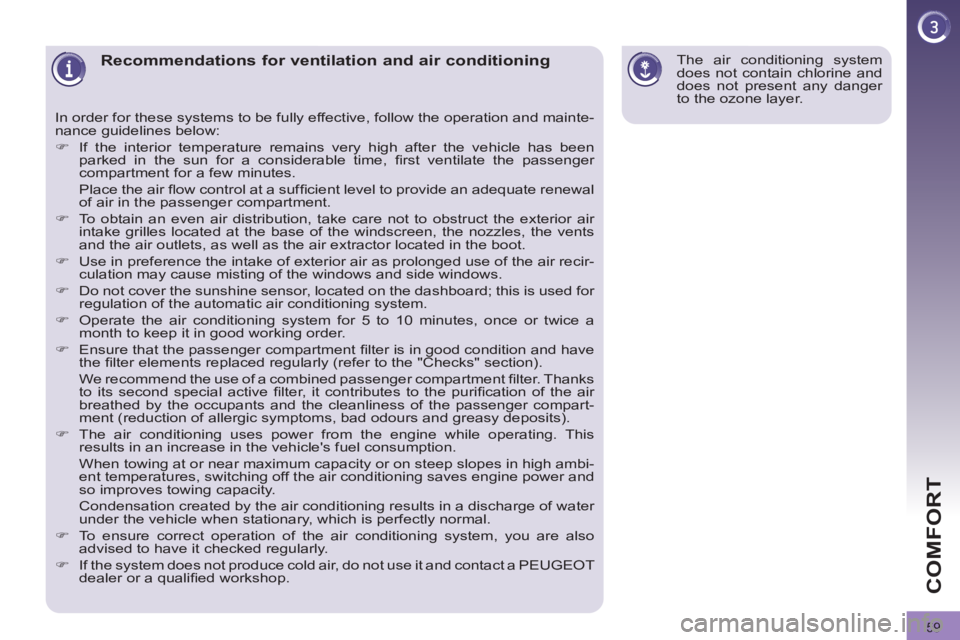
59
COMFORT
Recommendations for ventilation and air conditioning
In order for these systems to be fully effective, follow the operation and mainte-
nance guidelines below:
�)
If the interior temperature remains very high after the vehicle has been
parked in the sun for a considerable time, fi rst ventilate the passenger
compartment for a few minutes.
Place the air fl ow control at a suffi cient level to provide an adequate renewal
of air in the passenger compartment.
�)
To obtain an even air distribution, take care not to obstruct the exterior air
intake grilles located at the base of the windscreen, the nozzles, the vents
and the air outlets, as well as the air extractor located in the boot.
�)
Use in preference the intake of exterior air as prolonged use of the air recir-
culation may cause misting of the windows and side windows.
�)
Do not cover the sunshine sensor, located on the dashboard; this is used for
regulation of the automatic air conditioning system.
�)
Operate the air conditioning system for 5 to 10 minutes, once or twice a
month to keep it in good working order.
�)
Ensure that the passenger compartment fi lter is in good condition and have
the fi lter elements replaced regularly (refer to the "Checks" section).
We recommend the use of a combined passenger compartment fi lter. Thanks
to its second special active fi lter, it contributes to the purifi cation of the air
breathed by the occupants and the cleanliness of the passenger compart-
ment (reduction of allergic symptoms, bad odours and greasy deposits).
�)
The air conditioning uses power from the engine while operating. This
results in an increase in the vehicle's fuel consumption.
When towing at or near maximum capacity or on steep slopes in high ambi-
ent temperatures, switching off the air conditioning saves engine power and
so improves towing capacity.
Condensation created by the air conditioning results in a discharge of water
under the vehicle when stationary, which is perfectly normal.
�)
To ensure correct operation of the air conditioning system, you are also
advised to have it checked regularly.
�)
If the system does not produce cold air, do not use it and contact a PEUGEOT
dealer or a qualifi ed workshop.
The air conditioning system
does not contain chlorine and
does not present any danger
to the ozone layer.
Page 109 of 328
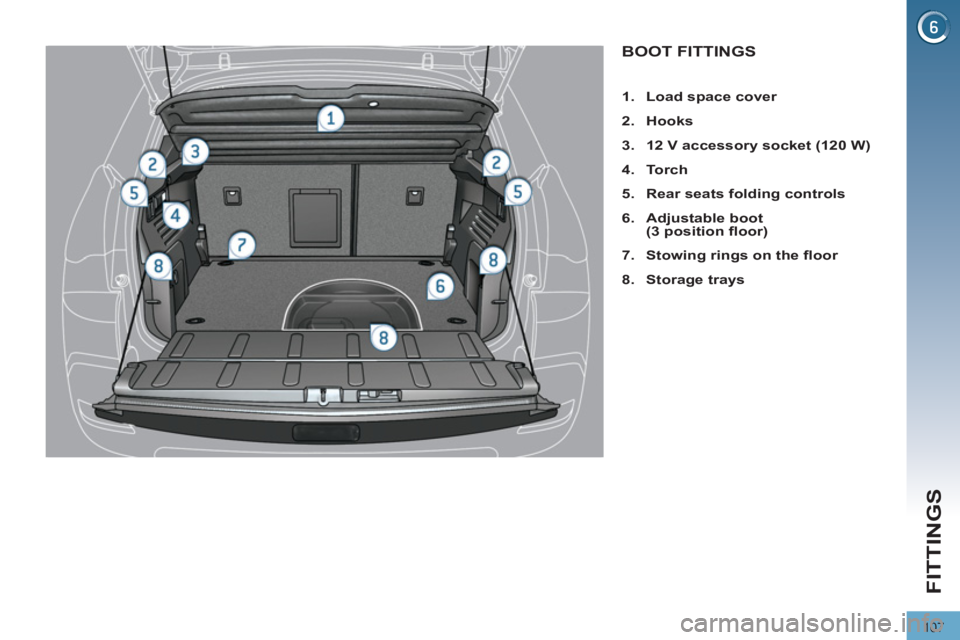
107
FITTINGS
BOOT FITTINGS
1.
Load space cover
2.
Hooks
3.
12 V accessory socket (120 W)
4.
To r c h
5.
Rear seats folding controls
6.
Adjustable boot
(3 position fl oor )
7.
Stowing rings on the fl oor
8.
Storage trays
Page 111 of 328
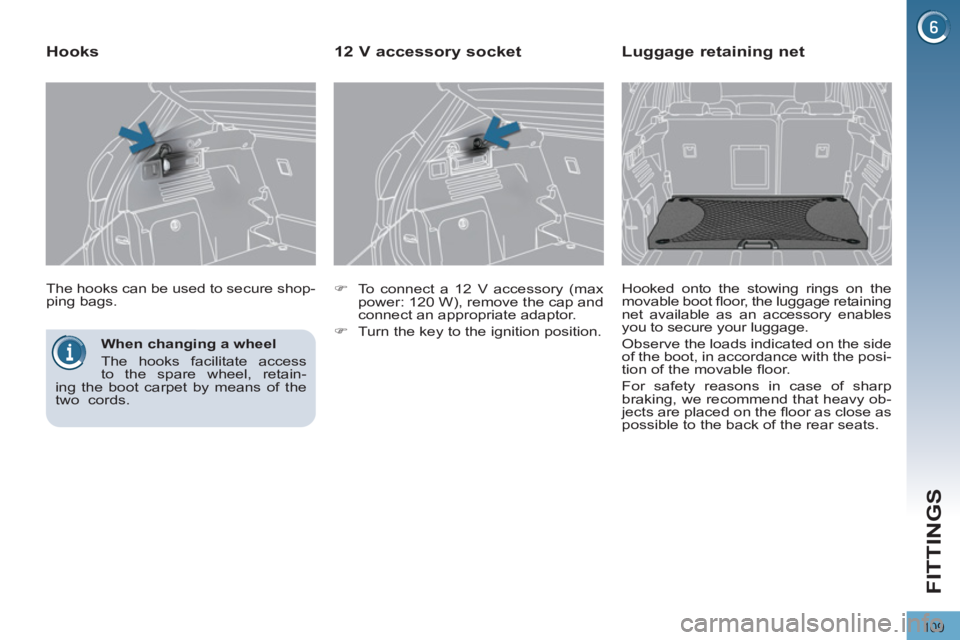
109
FITTINGS
When changing a wheel
The hooks facilitate access
to the spare wheel, retain-
ing the boot carpet by means of the
two cords.
The hooks can be used to secure shop-
ping bags.
Hooks
�)
To connect a 12 V accessory (max
power: 120 W), remove the cap and
connect an appropriate adaptor.
�)
Turn the key to the ignition position.
12 V accessory socket
Luggage retaining net
Hooked onto the stowing rings on the
movable boot fl oor, the luggage retaining
net available as an accessory enables
you to secure your luggage.
Observe the loads indicated on the side
of the boot, in accordance with the posi-
tion of the movable fl oor.
For safety reasons in case of sharp
braking, we recommend that heavy ob-
jects are placed on the fl oor as close as
possible to the back of the rear seats.
Page 113 of 328
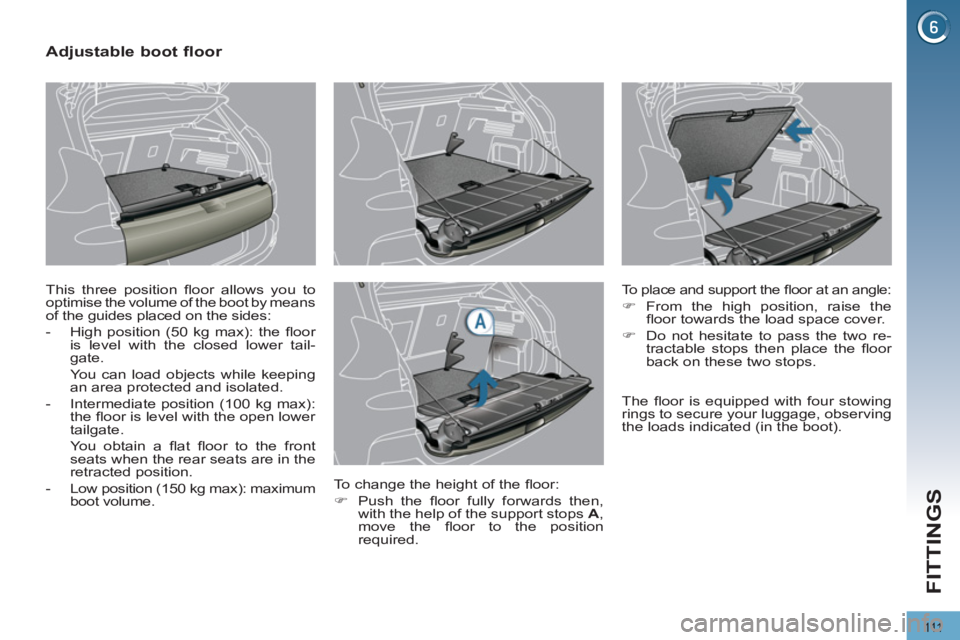
111
FITTINGS
Adjustable boot floor
This three position fl oor allows you to
optimise the volume of the boot by means
of the guides placed on the sides:
- High position (50 kg max): the fl oor
is level with the closed lower tail-
gate.
You can load objects while keeping
an area protected and isolated.
- Intermediate position (100 kg max):
the fl oor is level with the open lower
tailgate.
You obtain a fl at fl oor to the front
seats when the rear seats are in the
retracted position.
- Low position (150 kg max): maximum
boot volume.
To place and support the fl oor at an angle:
�)
From the high position, raise the
fl oor towards the load space cover.
�)
Do not hesitate to pass the two re-
tractable stops then place the fl oor
back on these two stops.
To change the height of the fl oor:
�)
Push the fl oor fully forwards then,
with the help of the support stops A
,
move the fl oor to the position
required.
The fl oor is equipped with four stowing
rings to secure your luggage, observing
the loads indicated (in the boot).
Page 126 of 328
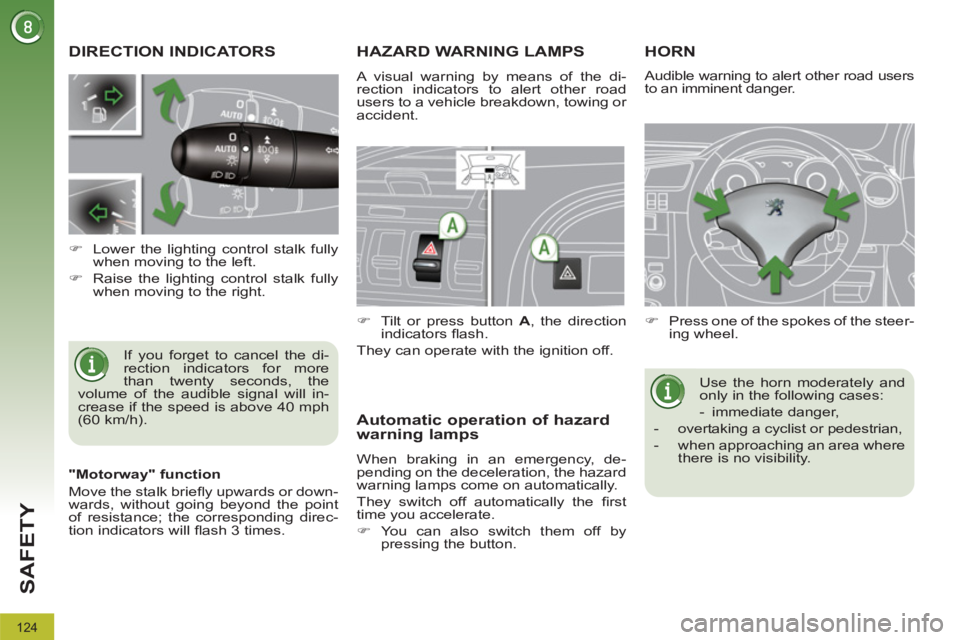
124
SAFETY
DIRECTION INDICATORS
If you forget to cancel the di-
rection indicators for more
than twenty seconds, the
volume of the audible signal will in-
crease if the speed is above 40 mph
(60 km/h).
�)
Lower the lighting control stalk fully
when moving to the left.
�)
Raise the lighting control stalk fully
when moving to the right.
HAZARD WARNING LAMPS
A visual warning by means of the di-
rection indicators to alert other road
users to a vehicle breakdown, towing or
accident.
�)
Tilt or press button A
, the direction
indicators fl ash.
They can operate with the ignition off.
Automatic operation of hazard
warning lamps
When braking in an emergency, de-
pending on the deceleration, the hazard
warning lamps come on automatically.
They switch off automatically the fi rst
time you accelerate.
�)
You can also switch them off by
pressing the button.
HORN
�)
Press one of the spokes of the steer-
ing wheel.
Use the horn moderately and
only in the following cases:
- immediate danger,
- overtaking a cyclist or pedestrian,
- when approaching an area where
there is no visibility.
Audible warning to alert other road users
to an imminent danger.
"Motorway" function
Move the stalk briefl y upwards or down-
wards, without going beyond the point
of resistance; the corresponding direc-
tion indicators will fl ash 3 times.
Page 139 of 328
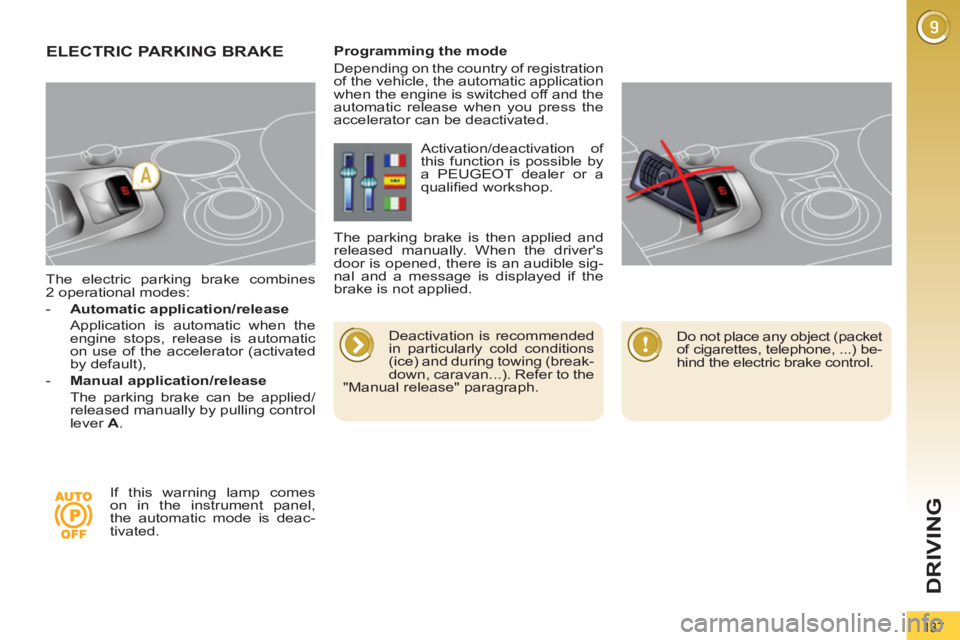
137
DRIVING
The electric parking brake combines
2 operational modes:
- Automatic application/release
Application is automatic when the
engine stops, release is automatic
on use of the accelerator (activated
by default),
- Manual application/release
The parking brake can be applied/
released manually by pulling control
lever A
.
ELECTRIC PARKING BRAKE
Deactivation is recommended
in particularly cold conditions
(ice) and during towing (break-
down, caravan...). Refer to the
"Manual release" paragraph.
Programming the mode
Depending on the country of registration
of the vehicle, the automatic application
when the engine is switched off and the
automatic release when you press the
accelerator can be deactivated.
If this warning lamp comes
on in the instrument panel,
the automatic mode is deac-
tivated. Activation/deactivation of
this function is possible by
a PEUGEOT dealer or a
qualifi ed workshop.
The parking brake is then applied and
released manually. When the driver's
door is opened, there is an audible sig-
nal and a message is displayed if the
brake is not applied.
Do not place any object (packet
of cigarettes, telephone, ...) be-
hind the electric brake control.
Page 140 of 328
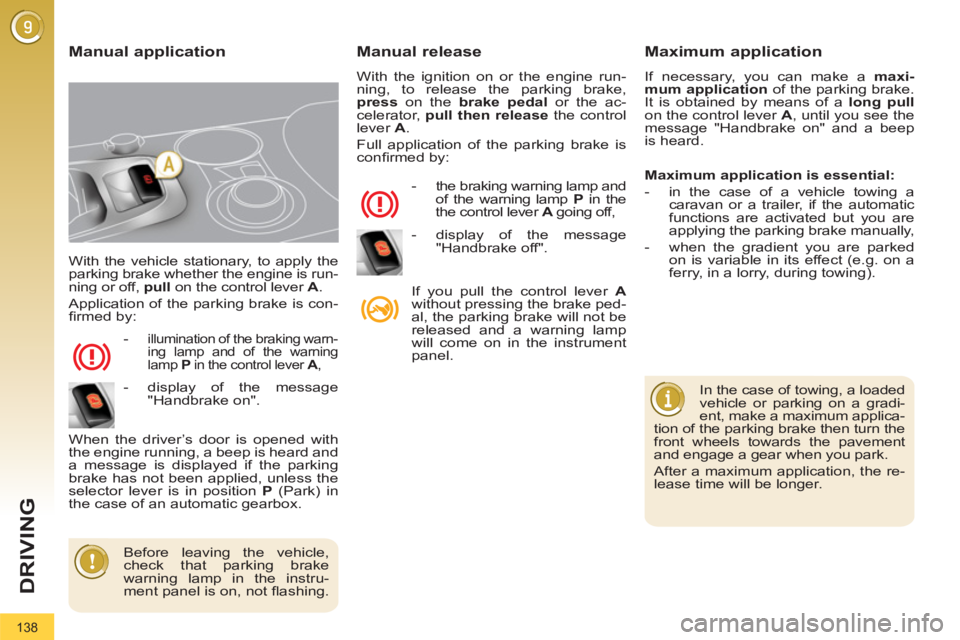
138
DRIVING
With the vehicle stationary, to apply the
parking brake whether the engine is run-
ning or off, pull
on the control lever A
.
Application of the parking brake is con-
fi rmed by:
-
illumination of the braking warn-
ing lamp and of the warning
lamp P
in the control lever A
,
When the driver’s door is opened with
the engine running, a beep is heard and
a message is displayed if the parking
brake has not been applied, unless the
selector lever is in position P
(Park) in
the case of an automatic gearbox.
Manual release
With the ignition on or the engine run-
ning, to release the parking brake,
press
on the brake
pedal
or the ac-
celerator, pull then release
the control
lever A
.
Full application of the parking brake is
confi rmed by:
- the braking warning lamp and
of the warning lamp P
in the
the control lever A
going off,
If you pull the control lever A
without pressing the brake ped-
al, the parking brake will not be
released and a warning lamp
will come on in the instrument
panel.
Manual application
Maximum application
If necessary, you can make a maxi-
mum application
of the parking brake.
It is obtained by means of a long pull
on the control lever A
, until you see the
message "Handbrake on" and a beep
is heard.
In the case of towing, a loaded
vehicle or parking on a gradi-
ent, make a maximum applica-
tion of the parking brake then turn the
front wheels towards the pavement
and engage a gear when you park.
After a maximum application, the re-
lease time will be longer.
Before leaving the vehicle,
check that parking brake
warning lamp in the instru-
ment panel is on, not fl ashing.
Maximum application is essential:
- in the case of a vehicle towing a
caravan or a trailer, if the automatic
functions are activated but you are
applying the parking brake manually,
- when the gradient you are parked
on is variable in its effect (e.g. on a
ferry, in a lorry, during towing).
- display of the message
"Handbrake on".
- display of the message
"Handbrake off".